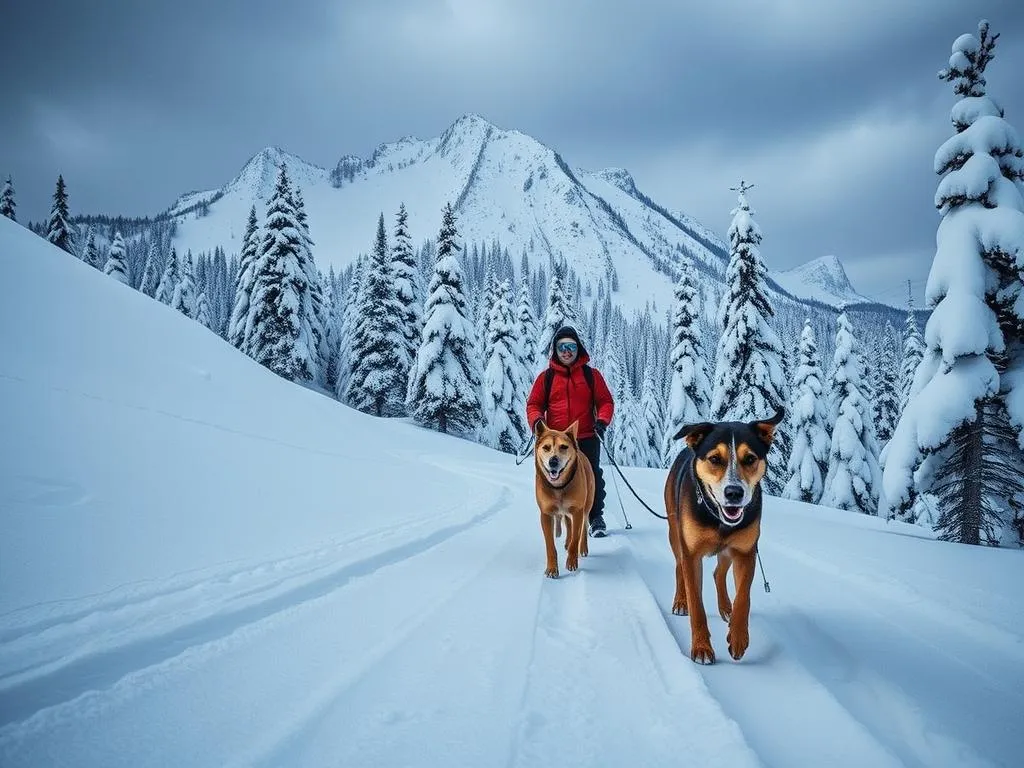
Introduction
Winter brings a unique kind of magic to the outdoors, transforming landscapes into snowy wonderlands perfect for adventure. Skiing and snowshoeing with dogs not only allow you to enjoy this pristine beauty but also provide an excellent opportunity for both you and your furry friend to stay active and healthy during the colder months. As the snow blankets the ground, it beckons outdoor enthusiasts and their loyal companions to explore the trails together.
Incorporating dogs into your winter excursions can enhance your experience. They bring joy, enthusiasm, and companionship, making every moment spent outdoors more rewarding. Plus, winter exercise is beneficial for both dogs and their owners, improving physical health, mental well-being, and social connectivity. Let’s dive deeper into the benefits, preparation, safety considerations, and tips for a successful adventure skiing and snowshoeing with your dog.
Benefits of Skiing and Snowshoeing with Dogs
Physical Benefits
Engaging in skiing or snowshoeing with dogs offers numerous physical benefits for you and your pup. These activities provide an excellent cardiovascular workout, helping to improve stamina and heart health. Here are some key physical benefits:
- Enhanced Cardiovascular Fitness: Both skiing and snowshoeing require significant physical effort, which can improve cardiovascular fitness for both you and your dog.
- Weight Management: Keeping your dog active during winter can help manage their weight, especially when outdoor play is limited due to cold weather.
- Joint Health and Muscle Strengthening: Regular exercise, like skiing and snowshoeing, supports joint health and strengthens muscles, which is essential for dogs, especially as they age.
Mental Benefits
The mental stimulation gained from these activities is equally important. Dogs thrive on engagement, and winter sports provide an excellent opportunity for them to explore their surroundings.
- Stimulation and Engagement: The sights, sounds, and smells of a snow-covered landscape engage dogs’ natural instincts, keeping them alert and curious.
- Bonding Time: Spending time outdoors skiing or snowshoeing strengthens the bond between you and your dog, creating lasting memories.
- Stress Relief: The fresh air and physical activity can alleviate stress and improve mood for both you and your furry companion, making it a win-win situation.
Social Benefits
Outdoor activities like skiing and snowshoeing also offer social opportunities:
- Meet Other Dog Owners: Trails often attract fellow dog lovers, creating a chance to meet new people and share experiences.
- Building Community: Participating in group activities fosters a sense of community among outdoor enthusiasts, leading to friendships that extend beyond the trails.
Preparing for Your Adventure
Choosing the Right Location
Before heading out, it’s crucial to choose the right location for your adventure. Not all trails are dog-friendly, so research is key. Look for:
- Dog-Friendly Trails: Many ski resorts and parks offer designated dog-friendly trails. Ensure that the area allows dogs and check for any specific rules or regulations.
- Terrain and Difficulty Level: Consider your dog’s fitness and skill level when selecting a trail. Avoid overly steep or challenging terrains that could be hazardous for your dog.
Gear and Equipment
Having the right gear is essential for a safe and enjoyable experience. Here’s a breakdown of what you’ll need:
- Essential Gear for Dogs:
- Harness: A well-fitted harness provides better control and comfort.
- Booties: Protect your dog’s paws from snow and ice, which can cause injury or discomfort.
-
Reflective Gear: In low-light conditions, reflective gear will help keep your dog visible.
-
Recommended Gear for Owners:
- Skis or Snowshoes: Invest in quality equipment that suits your experience level.
-
Poles: Ski poles can enhance stability and help with navigation on snowy trails.
-
Safety Equipment:
- First Aid Kit: Always carry a first aid kit tailored for both humans and dogs.
- Dog GPS Tracker: In case your dog wanders off, a GPS tracker can help locate them quickly.
Assessing Your Dog’s Fitness Level
Before embarking on your winter adventure, assess your dog’s fitness level:
- Evaluate Readiness: Consider your dog’s age, breed, and general health when determining if they’re ready for skiing or snowshoeing.
- Gradual Acclimatization: Introduce your dog to snow and cold gradually. Start with short walks in the snow before hitting the trails for longer adventures.
Safety Considerations
Weather and Environmental Factors
Being aware of environmental conditions is crucial for your dog’s safety during winter sports:
- Signs of Cold Weather Stress: Watch for shivering, whining, or reluctance to move, indicating your dog may be feeling too cold.
- Frostbite and Hypothermia: Protect sensitive areas like paws and ears from frostbite, and know the signs of hypothermia, which can include lethargy or weakness.
Trail Etiquette
Understanding trail etiquette is vital for a harmonious outdoor experience:
- Leash Laws: Adhere to leash laws in the areas you visit. Keeping your dog on a leash ensures they remain under control and safe.
- Sharing the Trail: Be courteous to other skiers and snowshoers. Keep your dog close and be mindful of their presence on the trail, especially around others.
Health Precautions
Maintaining your dog’s health during outdoor activities is essential:
- Hydration and Nutrition: Always bring water for both you and your dog. Ensure your dog is well-hydrated and consider bringing snacks for longer outings.
- Regular Breaks: Schedule breaks to allow your dog to rest, assess their condition, and avoid overexertion.
Tips for a Successful Skiing and Snowshoeing Experience
Training Your Dog
Preparation is key to a successful skiing or snowshoeing experience:
- Basic Commands: Train your dog in essential commands like “stay,” “come,” and “heel” to maintain control during your adventure.
- Building Endurance: Gradually increase the duration and intensity of your walks to build your dog’s endurance and comfort in snowy conditions.
Creating a Positive Experience
Making the experience enjoyable for your dog is crucial:
- Engagement with Toys and Treats: Bring along toys or treats to keep your dog engaged and motivated during breaks.
- Know When to Turn Back: Pay attention to your dog’s energy levels. If they seem tired or unwilling, it’s best to turn back and save the adventure for another day.
Documenting the Adventure
Capture the memories of your winter outings:
- Photographing Your Experience: Bring a camera or use your smartphone to document your adventures. Capture candid moments of your dog enjoying the snow, as well as the stunning landscapes.
- Sharing on Social Media: Consider sharing your experiences on social media, connecting with other dog lovers and outdoor enthusiasts.
Conclusion
Skiing and snowshoeing with dogs are fantastic ways to embrace the winter season while staying active and healthy. The physical, mental, and social benefits of these outdoor activities enrich the lives of both dogs and their owners. With the right preparation, safety considerations, and tips, you’ll create unforgettable memories and strengthen your bond with your furry friend.
Exploring the winter wilderness together opens up a world of joy and adventure, fostering an appreciation for nature and a deeper connection with your canine companion. So, grab your gear, hit the trails, and let the snowy landscape be your playground this winter!









